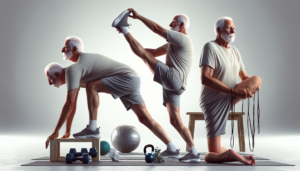Improving Flexibility in Senior Men
As I embark on the journey of enhancing flexibility in senior men, I understand the significance of flexibility training and the numerous benefits it brings to us as we age.
Importance of Flexibility Training
Flexibility training plays a vital role in my daily routine as a senior man. It allows me to maintain a healthy range of motion in my joints, reducing stiffness and enhancing my overall mobility. With age, our bodies naturally undergo changes that can lead to a decline in flexibility, making simple tasks more challenging. However, through dedicated stretching routines for seniors, I can counteract these effects and improve my quality of life.
By incorporating stretching exercises for senior men into my fitness regimen, I can enhance my joint health, prevent injuries, and promote better posture. Flexibility training not only benefits my physical well-being but also contributes to my mental health by reducing stress and promoting relaxation.
Benefits of Flexibility in Aging
As I embrace the journey of aging, I am aware of the wide array of benefits that flexibility brings to me. Studies have shown that flexibility training can lead to an increased range of motion, particularly in the hamstring muscle group, regardless of the type of stretching exercise performed (NCBI). Maintaining flexibility is essential for preventing postural imbalances, movement limitations, and the increased risk of falling that often accompany aging.
One of the key advantages of flexibility training is its ability to reverse age-related flexibility loss. With the right exercises and consistent effort, improvements in flexibility can be achieved, enabling me to enjoy a more active and independent lifestyle. Engaging in a senior male mobility routine that includes dynamic and static stretching exercises can significantly contribute to enhancing my flexibility and overall well-being.
Understanding the importance of flexibility in aging and the transformative impact it can have on my daily life, I am committed to incorporating flexibility exercises for senior men into my fitness routine. By prioritizing flexibility training, I am taking a proactive approach to maintaining my health, vitality, and independence as a senior man.
Exercise Recommendations for Older Men
When it comes to maintaining flexibility and mobility as we age, incorporating regular physical activity into our routines is essential. For older men looking to improve joint health, reduce stiffness, and increase overall mobility, a well-rounded exercise plan is key. Here, I will discuss some recommended physical activities and how to effectively incorporate flexibility exercises for older men.
Recommended Physical Activities
To meet the recommended amount of physical activity for seniors, it’s beneficial to break down exercise routines into manageable chunks. According to the Centers for Disease Control and Prevention (Healthline), seniors aged 65 and older should aim for 150 minutes of moderate endurance activity per week. This can include activities like walking, swimming, cycling, and exercises that target strength, flexibility, and balance.
By incorporating a variety of physical activities into your week, you can improve cardiovascular health, muscle strength, and overall well-being. Some example exercises for seniors to build strength include abdominal contractions, wall pushups, pelvic tilts, shoulder blade squeeze, toe taps, heel raises, knee lifts, shoulder and upper back stretches, ankle rotations, and balance boosters (Healthline).
Incorporating Flexibility Exercises
When it comes to improving flexibility specifically, incorporating targeted flexibility exercises into your routine is crucial. While flexibility training interventions have shown improvements in joint range of motion and flexibility outcomes for older adults, further research is needed to determine the impact on functional outcomes and daily functioning (NCBI). Despite this, many older adult activity programs emphasize flexibility as a key component of overall fitness.
Different flexibility training methods can be utilized, from simple static stretches to more advanced techniques like proprioceptive neuromuscular facilitation (PNF) (NCBI). Research suggests that PNF methods may be more effective than non-PNF techniques for improving flexibility outcomes in older adults.
To create an effective flexibility program for older men, it’s important to consider individualized goals and tailor the exercises to meet specific needs. The goal of a flexibility program is to enhance range of motion in major muscle-tendon groups, ultimately improving functional abilities in daily activities (NCBI). By incorporating a variety of stretching exercises and techniques into your routine, you can work towards maintaining and improving your flexibility as you age.
For more specific flexibility exercises for older men and tips on building a comprehensive senior male flexibility program, consult with a fitness professional or healthcare provider to ensure your routine is safe and effective for your individual needs.
Specific Flexibility Exercises
When it comes to enhancing flexibility in older men, incorporating specific exercises targeting joint health and overall balance and coordination is essential for improving mobility. Let’s explore these key areas of focus in your senior male flexibility program.
Stretching for Joint Health
In your senior male flexibility program, incorporating stretching exercises geared towards joint health can help improve range of motion and joint flexibility. Studies have shown that static stretching exercises are effective in enhancing joint range of motion, particularly in sedentary and elderly individuals (NCBI). Static stretching can be particularly beneficial for older adults as it improves joint flexibility without significantly increasing muscle reflex activity, making it a safe and effective option.
Table: Joint Flexibility Improvement in Older Men
| Stretching Exercise | Frequency | Duration |
|---|---|---|
| Shoulder Stretch | 2-3 times per week | 15-30 seconds per stretch |
| Hamstring Stretch | Daily | 30 seconds per leg |
| Quadriceps Stretch | 3-4 times per week | 20 seconds per stretch |
| Calf Stretch | Daily | 15-20 seconds per leg |
To explore a variety of stretching routines tailored for seniors, visit our article on stretching routines for seniors. By incorporating these stretching exercises into your daily routine, you can gradually improve your joint flexibility and reduce stiffness, allowing for better movement and functionality in everyday activities.
Balance and Coordination Training
In addition to stretching exercises, balance and coordination training are crucial components of a comprehensive senior male flexibility program. These exercises help improve stability, reduce the risk of falls, and enhance overall mobility, which are particularly important for maintaining independence as you age.
Balancing exercises such as standing on one foot, heel-to-toe walk, and yoga poses like tree pose or warrior II can challenge your balance and coordination skills. These exercises not only strengthen your core and lower body muscles but also enhance proprioception, which is vital for preventing falls and maintaining agility.
To discover a range of balance and coordination exercises tailored for older men, check out our article on senior male flexibility workouts. By incorporating these exercises into your fitness routine, you can boost your balance, coordination, and overall mobility, enabling you to move with confidence and ease in your daily activities.
By focusing on stretching for joint health and incorporating balance and coordination training into your flexibility program, you can elevate your flexibility, reduce stiffness, and enhance your overall mobility as an older man. Remember to perform these exercises regularly and gradually progress to more challenging variations to continue improving your flexibility and functional abilities.
Overcoming Age-Related Flexibility Decline
As we age, it’s common to experience a decline in flexibility, which can impact our mobility and overall quality of life. However, the good news is that the loss of flexibility associated with aging is not permanent – it can be reversed through activity and the right exercises. By incorporating a senior male flexibility program into your routine, you can work towards regaining flexibility and improving joint health.
Reversing Age-Related Flexibility Loss
It’s never too late to start working on your flexibility. Improvements in flexibility can be achieved with the right exercise and activity, making age-related loss of flexibility reversible. Engaging in activities such as yoga, pilates, swimming, tai chi, dancing, massage, foam rolling, and stretching can all contribute to enhancing flexibility and mobility (More Life Health). These activities not only help to increase flexibility but also promote relaxation and reduce stress, benefiting both your physical and mental well-being.
Studies have shown that various stretching techniques, including dynamic stretching, static stretching, and Proprioceptive Neuromuscular Facilitation (PNF) stretching, can significantly improve flexibility. Dynamic stretches involve active movements repeated in a short period, static stretches are held for 30-60 seconds, and PNF stretching involves muscle contractions while stretching. By incorporating a combination of these stretching techniques into your routine, you can target different muscle groups and enhance your overall flexibility.
Importance of Daily Stretching
One of the key components of a successful flexibility program is the consistency of practice. Daily stretching plays a vital role in maintaining and improving flexibility, especially for older men. Stretching exercises have been recommended to counteract the negative effects of decreased flexibility in aging individuals. These exercises can help increase the range of motion in various muscle groups, particularly in areas prone to stiffness, such as the hamstrings.
In addition to incorporating stretching exercises, combining resistance training with various exercises can also contribute to improving flexibility in older adults (NCBI). Strength exercises help reduce passive tension and stiffness in the tissues surrounding the joints, ultimately enhancing range of motion. By integrating a well-rounded fitness regimen that includes both flexibility and strength training, you can work towards maintaining a healthy level of flexibility as you age.
Remember, consistency is key when it comes to regaining flexibility. By committing to a regular routine that includes a mix of stretching, strengthening, and mobility exercises, you can actively address age-related flexibility decline and enjoy the benefits of improved joint health and mobility in the long run. So, let’s embark on this journey together and prioritize our flexibility for a healthier and more active lifestyle.
Effective Flexibility Training Methods
When it comes to enhancing flexibility, incorporating the right training methods is essential for senior men looking to improve joint health and increase mobility. Two effective flexibility training methods that have shown promising results in improving flexibility are dynamic stretching and proprioceptive neuromuscular facilitation (PNF) stretching.
Dynamic vs. Static Stretching
Dynamic stretching and static stretching are two popular techniques that can help improve flexibility in older men. Dynamic stretching involves active movements that are repeated in a short period of time. These movements help to warm up the muscles, increase blood flow, and prepare the body for physical activity. On the other hand, static stretching involves holding a stretch position for 30-60 seconds to lengthen the muscle and improve flexibility.
Dynamic stretching is beneficial for improving overall range of motion and enhancing muscle performance before engaging in physical activities. It helps to improve flexibility, mobility, and joint function, making it an excellent choice for warming up before exercise. On the other hand, static stretching is effective for increasing muscle flexibility and reducing muscle stiffness, making it a valuable addition to a senior male mobility routine.
Proprioceptive Neuromuscular Facilitation (PNF)
Proprioceptive neuromuscular facilitation (PNF) stretching is a more advanced flexibility training method that involves a combination of stretching and muscle activation. PNF stretching techniques typically include contracting and relaxing specific muscle groups while in a stretched position. This method has been found to be particularly effective in improving flexibility outcomes in older adults compared to non-PNF techniques.
Incorporating PNF stretching into your flexibility program can help target specific muscle groups, increase flexibility, and enhance overall joint range of motion. By engaging in PNF stretching exercises, senior men can experience improved muscle flexibility, reduced muscle tension, and enhanced functional movement patterns.
By utilizing a combination of dynamic stretching, static stretching, and PNF stretching techniques, senior men can design a comprehensive flexibility program that caters to their individual needs and goals. These flexibility training methods not only promote better joint health and range of motion but also contribute to overall mobility and well-being in older adults. Remember to consult with a fitness professional or healthcare provider before starting a new flexibility program to ensure safety and effectiveness.
Flexibility Training Guidelines
When developing a senior male flexibility program, certain considerations and strategies are key to achieving optimal results. Focusing on tailored flexibility exercises can help improve joint health, reduce stiffness, and enhance overall mobility.
Flexibility Program Considerations
When crafting a flexibility program for older men, it’s essential to take into account individual needs and limitations. Prioritize exercises that target major muscle groups and joints while ensuring proper alignment and form. Incorporating a variety of stretching routines for seniors can help enhance flexibility in different areas of the body.
| Exercise | Target Area | Repetitions |
|---|---|---|
| Abdominal Contractions | Core | 10-15 |
| Wall Pushups | Chest & Arms | 12-15 |
| Shoulder Blade Squeeze | Upper Back | 10-12 |
| Ankle Rotations | Ankles | 8-10 each direction |
For more stretching routines suitable for seniors, check out our article on stretching routines for seniors.
Balancing Strength and Flexibility
Incorporating strength-building exercises alongside flexibility training is crucial for a well-rounded fitness regimen. Exercises like pelvic tilts and balance boosters can aid in enhancing stability while increasing range of motion. By combining targeted strength and flexibility exercises, older men can improve mobility and reduce the risk of injuries.
To ensure a balanced approach to fitness, consider adding mobility workouts that focus on functional movements to enhance overall physical performance. Explore our article on senior male mobility routine for additional insights on maintaining mobility and flexibility through targeted exercises.
By prioritizing the harmony between strength and flexibility in your training regimen, you can effectively enhance your overall fitness and well-being. Remember, consistency is key when it comes to reaping the benefits of flexibility exercises for older men. For a range of specific flexibility exercises tailored for older men, refer to our article on flexibility exercises for older men.



